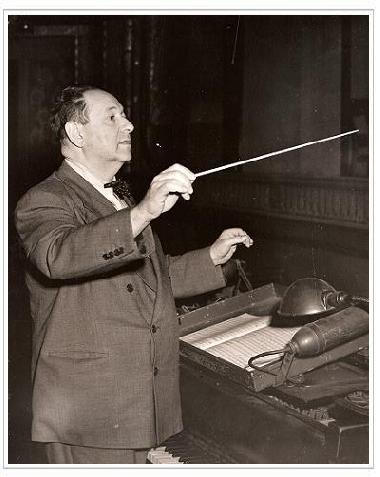Erich Wolfgang Korngold (1897-1957)
Born May. 29, 1897 in Brünn, Moravia (today, Brno, The Czech Republic).
Died November 29, 1957 in Hollywood.

Theme and Variations for school orchestra, Op. 42
Composed in 1953.
First Performance: Inglewood, November 22, 1953.
Instrumentation: 2 flutes, oboe, 2 clarinets, bassoon, 2 horns, 2 trumpets, 2 trombones,
timpani, cymbal, snare drum, bell, harp, piano, strings.
The son of the famous music critic Julius Korngold, Erich Korngold began his career in the early twentieth century as a wunderkind composer. He played his cantata Gold for Mahler who recognized his genius and sent him to Alexander Zemlinsky, Alma Mahler’s former teacher and brother in law of Schoenberg for orchestration lessons. His Piano Sonata was performed by Schnabel all over Europe. Upon hearing his first orchestral works – the Schauspiel Ouvertüre (1911) and the Sinfonietta (1912) – Richard Strauss remarked, “One’s first reaction that these compositions are by an adolescent boy are those of awe and fear.” Likewise his one act opera Violanta (1916) impressed Puccini. His early success was crowned by his full length opera Die tote Stadt (1920) which was premiered simultaneously in Hamburg and Cologne.
Max Reinhardt, with whom he had collaborated on a staging of Die Fledermaus in 1928, invited Korngold to Hollywood in 1934. He remained in Hollywood – becoming a US citizen in 1943 – until after the Second World War, becoming a US citizen in 1943. He earned two Oscars for the film scores to Robin Hood and Anthony Adverse. He suffered the fate of many child prodigies and was unfairly characterized as going “from Genius to Talent,” having become a composer of mere movie music. Just as the music of J.S. Bach was considered old-fashioned when he wrote it, so was Korngold’s lush late romantic style. The Symphony in F Sharp, Op. 40 (1951-2) was his last great full symphonic work.
Korngold’s wife related that he remarked, “From the time I was a boy I knew I would not make it beyond Opus 42.” While there was some truth to his prediction, if his movie scores are counted, he produced many more than 42 works.
Korngold’s final orchestral works were the Theme and Variations and Straussiana (on unfamiliar themes by Johann Strauss). They were written for American school orchestras on commission from an American music publisher.
The Theme and Variations begins with the theme simply presented by a flute over a serene background. The theme was composed by Korngold, but he directed in the score that it should be played in the manner of an Irish folk tune.
Example 1. The Theme
The theme is followed by seven clearly delineated variations.
- Allegretto (the theme)
- Pochissimo piu animato (1st variation)
- Piu mosso (2nd)
- L’istesso tempo (3rd) also titled scherzando
- Meno. cantabile e grazioso (4th)
- Allegro molto (5th)
- Molto meno mosso, lento (6th)
- Marcia (7th)
The first variation is very slightly faster in which the notes of the theme are repeated twice in the violins. The entire brief variation is repeated. The “more movement (i.e. faster)” variation finds the theme presented as sixteenth notes in the strings amid interjections from the horn. The third variation stays in this faster tempo using the dotted rhythm from Beethoven’s Ninth. The pace is calmer in the sings and graceful fourth variation where the theme in mainly in the strings but each woodwind has a comment. Things brighten again in the Allegro molto fifth variation where the theme is again in the strings with brief interjections from the flutes. The tempo and mood of the sixth variation is contrastingly very slow with impassioned string phrased punctuated by a rising clarinet. The final Marcia movement recalls the heroic style of Korngold’s movie scores,where one might imagine Errol Flynn dashing through Sherwood Forrest.
Resources
[amazon template=iframe image&asin=B00000426H][amazon template=iframe image&asin=B0000BX5L0][amazon template=iframe image&asin=B000003ER4][amazon template=iframe image&asin=B002V988OS][amazon template=iframe image&asin=B0000061JA]
